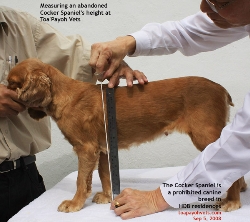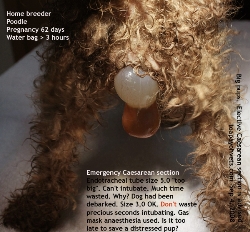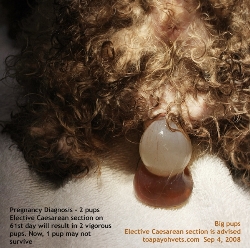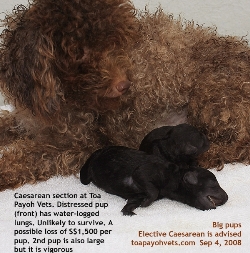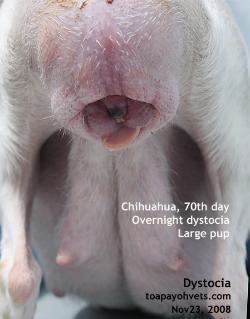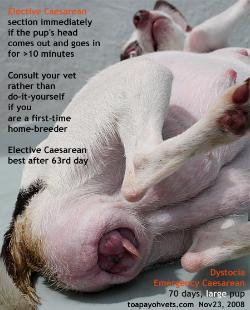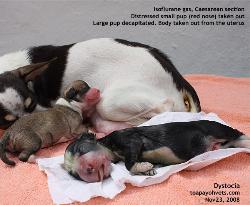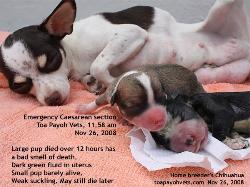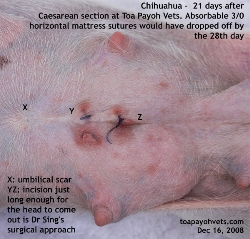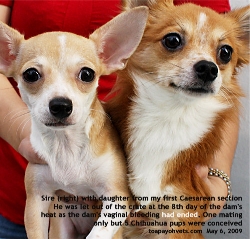"I have been lazy," the home-breeder replied when I told him that he could have 2 strong and vigorous pups if he had gone for elective Caesarean section after 60th day of pregnancy.
He had also waited more than 3 hours to seek a Caesarean section when the water bag appeared. If he had immediately called a veterinarian to do a Caesarean section on seeing the water bag hanging loose from his Poodle, he would have saved that pup. When I did the Caesarean section, the pup whose water bag had hung out from the dam for >3 hours was in great distress. Water bubbled out from her lungs. I swung her and rubbed her. She cried weakly. She was barely alive. She was not vigorous unlike the second pup. So, I doubt she would make it.
Here are the tips for the home-breeder:
1. Have a good relationship with a veterinarian. Obviously if you doctor-hop, you can't develop a veterinarian-client relationship of trust.
2. Get pregnancy diagnosis at the 28th day after the first mating.
3. Small toy breeds like Yorkshire Terriers do need Caesarean section. Delays lead to distressed pups which cannot suckle and need close nursing and stomach feeding. Many home breeders don't know how to do it and the pup dies after 2 days.
4. Be vigilant if you don't wish to pay for elective Caesarean sections. Sometimes the dam can give birth naturally. You will need to monitor the dam. Once the dam can't give birth after 2 hours, contact your veterinarian and get the Caesarean section done.
5. A change of mindset. After all, the objective of breeding is to produce live pups, not to save money on Caesarean section. Consult your veterinarian regularly.
Here are the tips for the veterinarian:
1. Time is of the essence. Do not
waste time trying to pull out the puppy since
it is likely to be stuck inside.
2. Intubation is ideal. However, in some case
such as this case, the dam has been debarked.
The normal size 5 endotracheal tube cannot
enter the trachea. A size 3 endotracheal tube
could. However, much time is wasted as the dog
wakes up and struggles. In this case, a face
mask giving isoflurane gas is used without
problem. The vet assistant does nothing but
monitor the anaesthesia - tongue colour, pedal
reflexes and breathing rates.
3. Use the minimal maintenance dose of gas.
0.5 - 1% was all right for this toy poodle.
In conclusion, the home-breeder needs to care
for the health of the dam. Elective Caesarean
costs money. But many times, they are the best
choice for toy breeds with big pups. Viable
and vigorous pups are delivered. The dam is
much less distressed by prolonged dystocia or
die in cases where dystocia drags on for many
hours. Her pups are most likely to survive the
first 2 weeks and the breeder spends less time
nursing distressed or orphaned pups.
| Case Study 2. The Chihuahua Could Not Give Birth Naturally |
An
elective or prompt Caesarean would have saved
the large pup. As the absorbable 3/0 stitch
did not dissolve and drop out on day 21 after
the Caesarean section, the owner brought in
the fiercely protective dam for examination on
Dec 16, 2008.
The puppy was "sucking" the stitches. I
removed the 2 horizontal mattress stitches.
The happy 11-year-old daughter told me that
the pup was thriving and growing bigger. It
was good news.
In retrospect, an elective Caesarean section
done around the 60th - 63rd day would have
given the owner 2 live pups. "59-63 days"
after mating is one of the range of dates for
birth of puppies in the dog. "70 days" will be
overdue as you can see the fully developed
coat of the pups.
Disappearing puppies for the
non-professional home breeder
I spoke to the owner in May 2009 when the dam
came in for a second Caesarean section. This
was an elective Caesarean section. The
pup did disappear between the fridge and the
washing machine. Fortunately, she was
discovered when the owners found her missing
and looked everywhere for her.
A nesting box with a wall of around 10
cm would have prevented pups from homing
towards a hot source (the refrigerator)
instead of the dam's body. Pups can't tell the
difference and some have had died due to this
lack of barrier.
VETERINARY TIPS:
1. An X-ray or ultra-sound scan at
60th day would have revealed the large pup
which would never be born naturally.
Abdominal palpation would also reveal a larger
than normal pup but the vet needs to be a bit
more experienced in abdominal palpation.
However X-rays and ultra-sound scans cost
money and no owner or professional breeder
wants to spend money.
2. Each veterinarian has his own
preferences in the surgical approach to
Caesarean section. I find that the shortest
skin and uterine incision sufficient to get
the head and body out has less problems of
stitch biting and breakdown. It also shortens
the anaesthetic time.
Other vets may feel more comfortable making a
longer incision, take out the whole womb of
the body, incise the uterus, get the pups out.
Then they flush the abdomen with saline and
put in some antibiotic liquid (or tablets)
before closing the abdomen. A professional
dog breeder was impressed by the
flushing of the uterus with saline to remove
the blood present after Caesarean.
3. My procedure after stitching up
the uterus:
I don't do it as I believe that the less
outside solutions or medication introduced
into the abdomen, the better it is for the
dam. Such external solutions can never be
sterile and may cause peritonitis. So why take
the risk? I press the abdomen to get as much
blood out of the abdomen as possible. I use
sterile cotton swabs to remove the blood.
As each veterinarian has his own procedure, it
is a matter of professional difference in the
approach to surgery and asepsis.
| Case Study 3. The Chihuahua Killed Her Puppies |
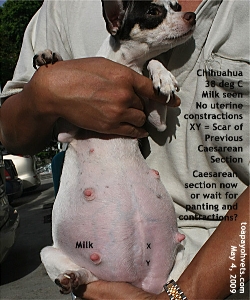 An
elective Caesarean section for the heavily
pregnant Chihuahua is necessary as the dam may
be unable to contract her womb to expel all 5
pups. Proper planning with your
veterinarian to get the Caesarean section done
during office hours will save the home-breeder
a lot of money and worry. This was what
happened to the owner of the Chihuahua from
Case Study 2.
An
elective Caesarean section for the heavily
pregnant Chihuahua is necessary as the dam may
be unable to contract her womb to expel all 5
pups. Proper planning with your
veterinarian to get the Caesarean section done
during office hours will save the home-breeder
a lot of money and worry. This was what
happened to the owner of the Chihuahua from
Case Study 2. Dam kills the puppies - Canine post-partum depression?
This does happen sometimes for reasons not well known. It would be likely due to stress. Or in human medicine - a post-partum depression when the mother felt like killing the baby.
I advised the owner regarding the possibility of the dam killing her 5 pups after the elective Caesarean Section. 5 pups appeared to me to be too much for her and she looked nervous. Something in her eye glare gave me an intuition that this dam would kill her puppies as there were too many. A surrogate dam would be used to suckle the 4 pups but this was a home-breeder without such a fall-back support.
The dam was cleaned up. Red blood shot out from her vagina and onto the towel as she was photographed. "There is nothing to worry," I said. "This bleeding is common after Caesarean Section. It will stop within 2 days."
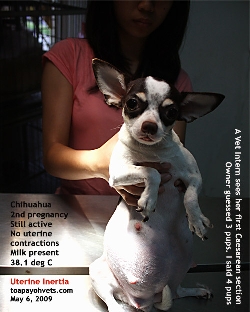 Then
I advised: "Nobody should be able to get
a good night's sleep tonight. There must be a 24-hour vigilance and
monitoring of the mother. One person must be
there all the time and feed the puppies with
some milk from the milk bottle. It is possible
that this mother will bite and kill her
puppies."
Then
I advised: "Nobody should be able to get
a good night's sleep tonight. There must be a 24-hour vigilance and
monitoring of the mother. One person must be
there all the time and feed the puppies with
some milk from the milk bottle. It is possible
that this mother will bite and kill her
puppies." "She will not do it," the father was confident as the dam had successfully reared the first pup in the first Caesarean section (see pictures in Case 2).
NOTE:
The pregnancy was an accident. The owners felt sorry for the sire who was crated for the 7 days the dam had her heat (vulval bleeding). As the bleeding had stopped around the 7th day, the sire was given freedom. "Only one shot," the father told me. That was sufficient to cause pregnancy.
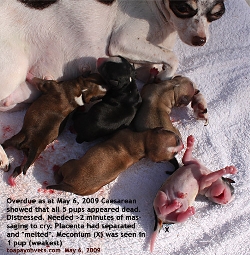 The father had wanted the spaying to be
done after Caesarean section. I
don't advise such a procedure as the dam had
to produce milk for her puppies. I don't know
whether such an operation would affect milk
production or the health of the dam.
The father had wanted the spaying to be
done after Caesarean section. I
don't advise such a procedure as the dam had
to produce milk for her puppies. I don't know
whether such an operation would affect milk
production or the health of the dam.In any case, the rectal temperature of the dam was 35.5 degrees C, half an hour after the end of the Caesarean section. The Chihuahua was shivering due to hypothermia. Glucose and dextrose saline IV was given. Calcium, Baytril antibiotic and Oxytocin injections were also given. The dam went home with the puppies to a happy family of two parents and 2 teenaged children. On May 7, 2009, 3 days after the Caesarean section, the 11-year-old daughter phoned me: "The mother bit 2 puppies in the stomach and the head. Blood came out. What can I do?" Two puppies had died when no family member was monitoring the dam. "Muzzle the dam," I said. "Or keep a 24-hour watch on the dam. Take away the puppy after suckling milk and use tissue paper to wipe the puppy's lower part and backside to stimulate the puppy to pee and poop."
The dam would not attack the remaining 3 puppies as a family member would be around. This seemed to be equivalent to a case of post-partum depression in women. I presumed that the baby would suffer adversely if the human mother was also severely depressed.
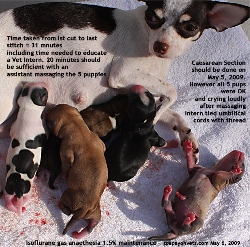 Many Singapore owners forget about
spaying the dam after the
Caesarean section. The best time to
spay the female would be at around 7th
-10th week after Caesarean section and
there would be no more milk in her
breast. The puppies should have been
weaned to solid food at the 4th to 5th
week.
Many Singapore owners forget about
spaying the dam after the
Caesarean section. The best time to
spay the female would be at around 7th
-10th week after Caesarean section and
there would be no more milk in her
breast. The puppies should have been
weaned to solid food at the 4th to 5th
week.
Due to forgetfulness, another
pregnancy may occur, even with "one
shot". It is like closing the
stable door when the horse has bolted?
Spaying can be done 1 month after the
puppies are weaned and there should be
no more milk in the dam.
I hope the above-mentioned tips from
real-life cases will be useful to many
home-breeders of small breeds and
veterinary students all over the
world.
|
Toa Payoh Vets Clinical
Research |
|
Copyright ©
Asiahomes Internet |
 TOA
PAYOH VETS
TOA
PAYOH VETS